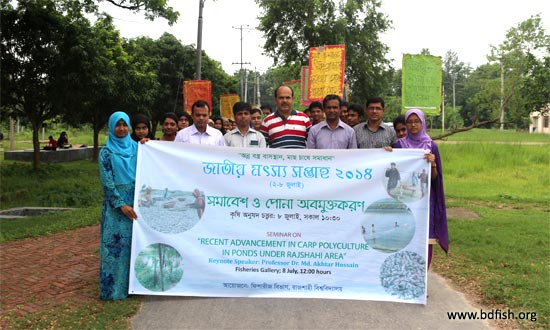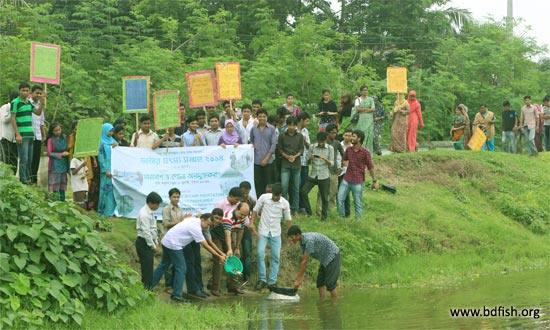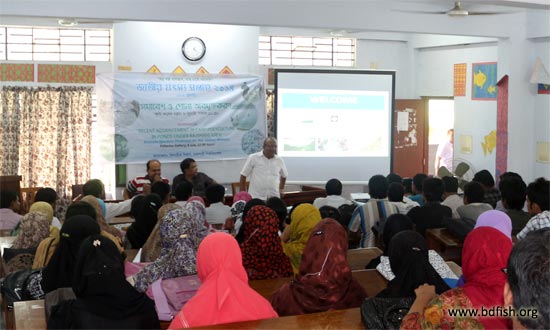
The National Fish Week 2014, held during July 2-8, was celebrated at the University of Rajshahi on July 08. On this occasion, day long program was undertaken by the Department of Fisheries. A rally, led by the Chairman of the department Dr. Md. Delwer Hossain, was brought out. The festive gathering was joined by the teaching staff and the students of the Department of Fisheries. The rally was concluded with a variety of fishes released by the Chairman and other teachers to the fisheries ponds.

In the wake of the rally, a seminar on “Recent advancement of carp polyculture in ponds under Rajshah area”, presided by the Chairman took place at the Fisheries Gallery. The District Fisheries Officer (DFO) of Rajshahi, Mr. Golam Rabbani was present as the Chief Guest while Dr. Md. Akhtar Hossain, Professor at the Department of Fisheries, delivered the keynote speech. Dr. Md. Delwer Hossain, Associate Professor and Chairman of the Department of Fisheries, greeted all with his welcome speech. In keynote speech, the speaker described the contributions, advancements and problems of aquaculture in the country. He has given major emphasis on the exploration of the potentials of regional aquaculture through his presentation/seminar.

The summary of his presentation is as follows:
Production, income, employment and performances of the entrepreneurs were evaluated for USDA/SEAF supported fish farming in ponds under Rajshahi district, Bangladesh for a period of 1 year from May 2013 to April 2014. A total of 40 aquaculture entrepreneurs were primarily selected as beneficiaries. Ten ponds (mean area of 1.28 ha and depth of 5.6 feet) of Paba Upazila under Rajshahi district were randomly selected for case studies. The major technical problems of fish farming were high plankton turbidity, plankton crashing (too clear/transparent water), fluctuation in pH values (lower and or higher pH values), shortage of dissolved oxygen during farming, gas bubble formation, changes in water color, stunted growth of fish, fin broken disease, fin erosion disease and ulcer disease. All the entrepreneurs were provided with module based training on different aspects of fish farming, facilitated with field laboratory for water quality monitoring, NLE (Network Learning Event) for experience sharing in advanced fish farming, ‘B’ to ‘B’ event (Business to Business Event) for linkage development and event for “meet the Bankers” for access to financial services. Feed and fertilizer based fish farming (only carp polyculture- 80%, tilapia-carp polyculture- 20%) including 5 to 7 species was found in the observed ponds. Initial stocking weight of carp was 300 g and that of tilapia was 75 g. Mean stocking density was 12 fishes/decimal for carp polyculture and 65 fishes/decimal for tilapia carp polyculture. Mean values of the water quality parameters were found within suitable range for fish farming. Major cost involving areas were found as application of supplementary feed (35%), lease value of the fish ponds (33%), stocking of fishes (25%), application of lime and fertilizer (4.5%) and others (2.5%). Tilapia-carp polyculture (fish production varied from 7.05 to 10.75 MT/ha/yr) was found more profitable over only carp polyculture ((fish production varied from 3.68 to 5.64 MT/ha/yr). Before and after analysis indicated increase in fish production (8.00 – 33.44%), net income (6.20 – 35.20%) and employment (40-100%). This study indicated that carp polyculture in ponds played effective role for enterprise development of Rajshahi area specially in producing larger sized fishes through fattening and in transporting and marketing live fishes at distant places. Variation in stocking size and inclusion of silver carp also affected the fish production and water quality. Reducing the cost o fish production especially through reducing the cost involvement in fish feed used by the entrepreneurs was identified as a major challenge during present effort.
Visited 1,350 times, 1 visits today | Have any fisheries relevant question?
